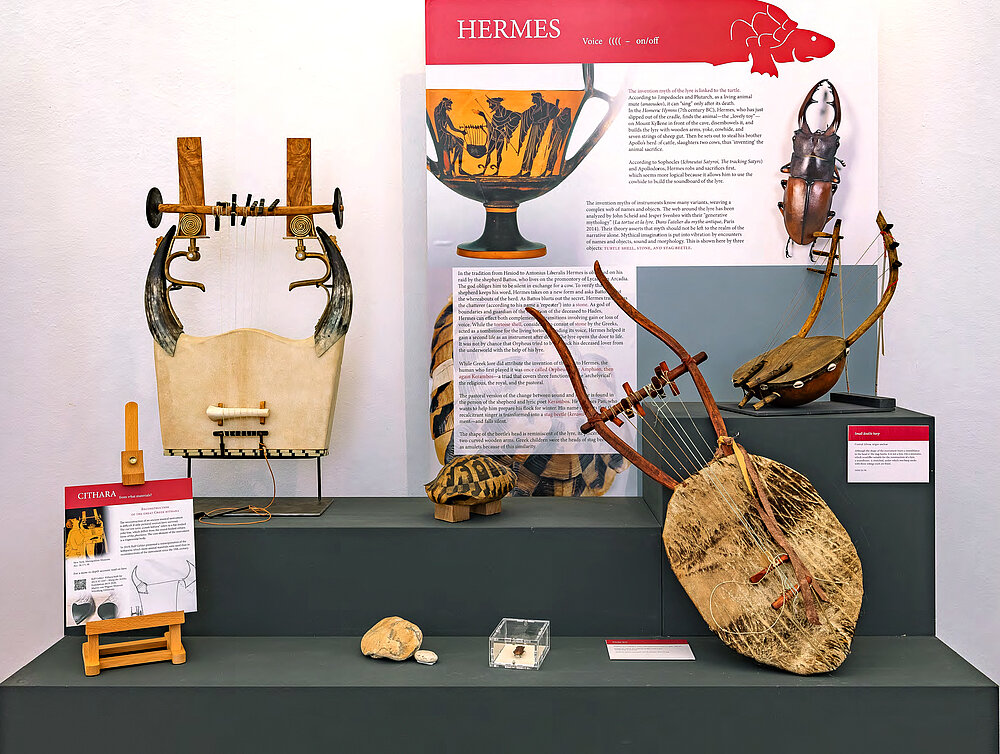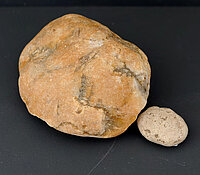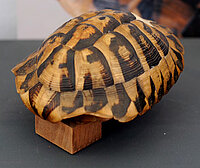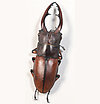Station VIII: Hermes

The invention myth of the lyre is linked to the turtle. According to Empedocles and Plutarch, as a living animal mute (anaoudos), it can “sing” only after its death. In the Homeric Hymns (prob. 7th century BC), Hermes, who has just slipped out of the cradle, finds the animal—the „lovely toy“—on Mount Kyllene in front of the cave, disembowels it, and builds the lyre with wooden arms, yoke, cowhide, and seven strings of sheep gut. Then he sets out to steal his brother Apollo’s herd of cattle, slaughters two cows, thus 'inventing' the animal sacrifice.
According to Sophocles (Ichneutai Satyroi, The tracking Satyrs) and Apollodoros, Hermes robs and sacrifices first, which seems more logical because it allows him to use the cowhide to build the soundboard of the lyre.
Invention myths of instruments know many variants, weaving a complex web of names and objects. The web around the lyre has been analyzed by John Scheid and Jesper Svenbro with a “generative mythology” (La tortue et la lyre. Dans l’ atelier du mythe antique, Paris2014). Their theory asserts that myth should not be left to the realm of the narrative alone. Mythical imagination is put into vibration by encounters of names and objects, sound and morphology. This is shown here by three objects: turtle shell, stone, and stag beetle.

In the tradition from Hesiod to Antonius Liberalis Hermes is observed on his raid by the shepherd Battos, who lives on the promontory of Lycaion in Arcadia. The god obliges him to be silent in exchange for a cow. To verify that the shepherd keeps his word, Hermes takes on a new form and asks Battos about the whereabouts of the herd. As Battos blurts out the secret, Hermes transforms the chatterer (according to his name a ‘repeater’) into a stone. As god of boundaries and guardian of the transition of the deceased to Hades, Hermes can effect both complementary transitions involving gain or loss of voice. While the tortoise shell, considered to consist of stone by the Greeks, acted as a tombstone for the living tortoise, binding its voice, Hermes helped it gain a second life as an instrument after death. The lyre opens the door to life. It was not by chance that Orpheus tried to bring back his deceased lover from the underworld with the help of his lyre.
In the tradition from Hesiod to Antonius Liberalis Hermes is observed on his raid by the shepherd Battos, who lives on the promontory of Lycaion in Arcadia. The god obliges him to be silent in exchange for a cow. To verify that the shepherd keeps his word, Hermes takes on a new form and asks Battos about the whereabouts of the herd. As Battos blurts out the secret, Hermes transforms
the chatterer (according to his name a ‘repeater’) into a stone. As god of boundaries and guardian of the transition of the deceased to Hades, Hermes can effect both complementary transitions involving gain or loss of voice. While the tortoise shell, considered to consist of stone by the Greeks, acted as a tombstone for the living tortoise, binding its voice, Hermes helped it gain a second life as an instrument after death. The lyre opens the door to life. It was not by chance that Orpheus tried to bring back his deceased lover from the underworld with the help of his lyre.
While Greek lore did attribute the invention of the lyre to Hermes, the human who first played it was once called Orpheus, once Amphion, then again Kerambos—a triad that covers three functions of the ‘archelyrical’: the religious, the royal, and the pastoral.
The pastoral version of the change between sound and silence is found in the person of the shepherd and lyric poet Kerambos. He opposes Pan, who wants to help him prepare his flock for winter. His name suggests that the recalcitrant singer is transformed into a stag beetle (kerambyx) as punishment—and falls silent.
The shape of the beetle’s head is reminiscent of the lyre, its pincers of the two curved wooden arms. Greek children wore the heads of stag beetles as amulets because of this similarity.









